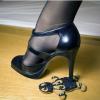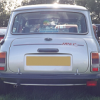
1989 - Owards Master Cylinder / Servo
#1

Posted 01 May 2012 - 07:33 PM
Mine is a green tag mounted on a servo, and I just cant bleed them at all, which is really annoying, every single hydraulic part is new, pipes the lot.
I have the bottom or the pipe closest to the servo feeding the front pipe, and the top, or the pipe further away from the servo feeding the rear brakes.
I have read some articles that describe both ways, but want to make sure by asking someone with same setup.
The pipes route into the PWDA on the bulkhead - big nut facing the engine bay.
Cheers,
RIchard.
#2

Posted 01 May 2012 - 09:48 PM
The forward end of the master cylinder goes to the top left (rear circuit) on the PRV, and the rear end of the master cylinder goes to the top right port on the PRV (front brakes). I checked that in the Rover workshop manual, just to be sure.
I believe that to be correct only for an equal bore master cylinder. If it is a stepped bore cylinder, the smaller bore (forward end) would have to feed the front brakes to get more pressure, but as far as I can tell, you would then not have, or need, a PRV.
Beware, probably 10mm and 12mm unions on master cylinder and 3/8 UNF on PRV. You probably know the dangers of that mixture already.
#3

Posted 03 May 2012 - 05:52 PM
#4

Posted 03 May 2012 - 08:00 PM
If all the pipe work is new you might need to bleed that before moving to the wheels, or you could be at it at some time. start off with the master, pumping the pedal and cracking the unions off same you would with the bleed nipples. The fronts should bleed up with not much hassle, but the rears you might need to bleed the t section on the rear subframe first.
This worked for me too. I started with the connections at the master cylinder, then bled each of the junctions in turn until I had fluid through to the wheel cylinders.
The rear was easier as I forgot to check that the nipple was closed before I filled the master cylinder. I came back the next day to fins a pool of brake fluid under the back of the car!
#5

Posted 04 May 2012 - 06:16 AM
Took the calipers off, used the ply to protect piston and caliper faces, wound the pistons back in with a g-clamp, pads back in, caliper on, pedal very, very firm! I wedged a bit of wood between the seat cross member and pedal as hard as possible to check all joints for drips where I found none, except the caliper bleed nippes "sweating" a bit, hopefully this was just fluid I had not wiped away fully or tiny bits naturally draining from the closed, but half full nipple.
Success at last!
Only problem now I have seen a nice set of 10" wheels!!
#6

Posted 04 May 2012 - 11:26 PM
Just curious as to why it is so, your fix is perfectly good and will probably help a lot of people.
#7

Posted 05 May 2012 - 08:35 AM
1 user(s) are reading this topic
0 members, 1 guests, 0 anonymous users















